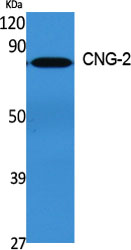CNG-2 Polyclonal Antibody
- 产品详情
- 实验流程
- 背景知识
Application
| WB, IF |
|---|---|
| Primary Accession | Q16280 |
| Reactivity | Human, Mouse, Rat |
| Host | Rabbit |
| Clonality | Polyclonal |
| Calculated MW | 76048 Da |
| Gene ID | 1260 |
|---|---|
| Other Names | CNGA2; CNCA; CNCA1; CNCG2; Cyclic nucleotide-gated olfactory channel; Cyclic nucleotide-gated cation channel 2; Cyclic nucleotide-gated channel alpha-2; CNG channel alpha-2; CNG-2; CNG2 |
| Dilution | WB~~Western Blot: 1/500 - 1/2000. Immunofluorescence: 1/200 - 1/1000. ELISA: 1/40000. Not yet tested in other applications. IF~~1:50~200 |
| Format | Liquid in PBS containing 50% glycerol, 0.5% BSA and 0.09% (W/V) sodium azide. |
| Storage Conditions | -20℃ |
| Name | CNGA2 {ECO:0000303|PubMed:11764791, ECO:0000312|HGNC:HGNC:2149} |
|---|---|
| Function | Pore-forming subunit of the olfactory cyclic nucleotide-gated channel. Operates in the cilia of olfactory sensory neurons where chemical stimulation of the odorant is converted to an electrical signal. Mediates odorant-induced cAMP-dependent Ca(2+) influx triggering neuron depolarization. The rise of intracellular Ca(2+) levels potentiates the olfactory response by activating Ca(2+)- dependent Cl(-) channels, but it also serves as a negative feedback signal to desensitize the channel for rapid adaptation to odorants. Conducts cAMP- and cGMP-gated ion currents, with permeability for monovalent and divalent cations. |
| Cellular Location | Cell projection, cilium membrane {ECO:0000250|UniProtKB:Q00195}; Multi-pass membrane protein |
Research Areas
For Research Use Only. Not For Use In Diagnostic Procedures.
Application Protocols
Provided below are standard protocols that you may find useful for product applications.
BACKGROUND
Odorant signal transduction is probably mediated by a G- protein coupled cascade using cAMP as second messenger. The olfactory channel can be shown to be activated by cyclic nucleotides which leads to a depolarization of olfactory sensory neurons.
终于等到您。ABCEPTA(百远生物)抗体产品。
点击下方“我要评价 ”按钮提交您的反馈信息,您的反馈和评价是我们最宝贵的财富之一,
我们将在1-3个工作日内处理您的反馈信息。
如有疑问,联系:0512-88856768 tech-china@abcepta.com.
¥ 1,500.00
Cat# AP69180























 癌症的基本特征包括细胞增殖、血管生成、迁移、凋亡逃避机制和细胞永生等。找到癌症发生过程中这些通路的关键标记物和对应的抗体用于检测至关重要。
癌症的基本特征包括细胞增殖、血管生成、迁移、凋亡逃避机制和细胞永生等。找到癌症发生过程中这些通路的关键标记物和对应的抗体用于检测至关重要。 为您推荐一个泛素化位点预测神器——泛素化分析工具,可以为您的蛋白的泛素化位点作出预测和评分。
为您推荐一个泛素化位点预测神器——泛素化分析工具,可以为您的蛋白的泛素化位点作出预测和评分。 细胞自噬受体图形绘图工具为你的蛋白的细胞受体结合位点作出预测和评分,识别结合到自噬通路中的蛋白是非常重要的,便于让我们理解自噬在正常生理、病理过程中的作用,如发育、细胞分化、神经退化性疾病、压力条件下、感染和癌症。
细胞自噬受体图形绘图工具为你的蛋白的细胞受体结合位点作出预测和评分,识别结合到自噬通路中的蛋白是非常重要的,便于让我们理解自噬在正常生理、病理过程中的作用,如发育、细胞分化、神经退化性疾病、压力条件下、感染和癌症。

.jpg)





